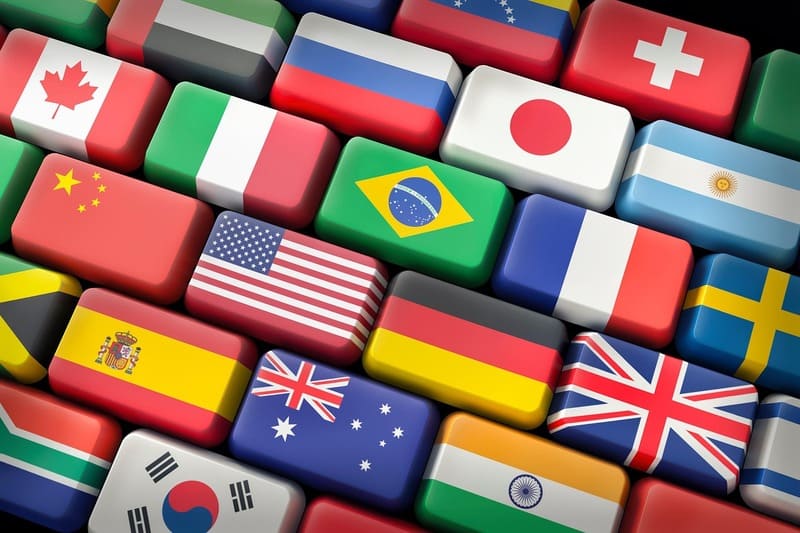In today’s digital era, accessing information has never been easier. As internet usage grows rapidly, every aspect of life, especially business, embraces digital transformation.
A company’s website is no longer just an online portfolio; it’s the first impression seen by the world —by partners, clients, and customers alike. And as businesses go global, website localization becomes essential.
How important is this service to businesses? Think about your own experience when visiting foreign websites. Have you ever accessed a website, any website, and been confused by its content?
You searched for information, landed on a foreign-language site, and used automatic translation to understand it. Maybe you used automatic translation, only to find the text awkward or inaccurate, making it even harder to understand.
Furthermore, the layout of the text was completely different. Even after translation, it can still be confusing. That’s why websites need localization. Although the internet makes everything more global, it still requires localization to target the right audience more effectively.
Translation vs. Localization — The Subtle Difference That Changes Everything
Translation is often confused with localization. However, the two are very different. Translation is the process of conveying meaning from one language into a target language, both contextually and literally. The goal is to convey information from the text or website in a different language.
Localization goes beyond translation—it adapts culture, language, visuals, and local formats like time, date, currency, and payments.
Furthermore, localization also considers the communication styles of local audiences. This is what makes your website a unique experience for your audience. Why? Because you’re not just conveying information in their language, but rather providing an experience for them.
To make things easier, let’s compare two websites: a literal translation and a localized one. An example of a localized website is Traveloka. The Traveloka Indonesia and Thailand websites differ in language, information layout, currency, and payment options.
Meanwhile, the website that was translated literally is the website of an Indonesian motorcycle store. The website was only translated by Google Translate, so it felt very stiff.
Why Southeast Asia Is the Perfect Playground for Website Localization
Southeast Asia, often perceived as a single region, is actually a rich tapestry of diversity. From the vibrant urban landscapes of Singapore and Bangkok to the serene Indonesian archipelago and the picturesque highlands of Vietnam, the region is home to 11 countries, hundreds of languages, and a myriad of cultural subtleties.
For businesses eyeing global expansion, Southeast Asia is not just a market; it’s a captivating realm for website localization services. What makes this region so fascinating is how digital culture intertwines with local identities.
Each country has its own unique way of communicating online. A phrase that sounds polite in Thailand might feel too formal, even stiff, to users in Indonesia. For example, the Thai word “Than,” used as a respectful prefix or title for respected individuals such as customers, officials, or superiors, would sound inappropriate if translated directly into Indonesian.
Conversely, a relaxed style favored in the Philippines might be considered too casual in Vietnam. Subtle differences like these demonstrate that localization is much more than just translation; it involves adapting tone, visuals, and digital experiences to suit local expectations.
The digital landscape of Southeast Asia is evolving rapidly. With a population exceeding 600 million and one of the world’s fastest internet adoption rates, the region presents a significant opportunity for brands that can resonate with the language and culture of their local users.
From e-commerce to fintech and lifestyle apps, well-localized websites have proven to be far more effective than a ‘one-size-fits-all’ approach, opening up a world of exciting possibilities.
In a region as diverse and rapidly changing as Southeast Asia, successful localization is not just about communication; it’s about forging meaningful connections.
Brands that invest in cultural understanding not only reach users but also earn trust, loyalty, and long-term growth. This emphasis on connection and understanding can reassure businesses about the potential benefits of successful localization.
Inside the Craft — How Website Translation Services Actually Work
Behind every natural-feeling multilingual website lies a lengthy process that’s more akin to art than technology. Imagine a team of localization professionals sitting around a screen, a translator, a localization manager, a proofreader, and a UX designer, each playing their role in a digital orchestra. Great localization is where technology ends and empathy begins.
It all starts with the translator. They stare intently at the first page, trying to capture not just the meaning of the words, but also the tone and emotion conveyed by the original text. “Buy now” might just be “Buy now,” but sometimes it takes more than that; sometimes it needs a sense of urgency unique to the local culture. The translator reads the context, understands the audience, and then rewrites with heart, not just changing words.
After that, the localization manager takes over. They set the overall tone, ensuring every element of the site aligns with the habits and expectations of users in the destination country.
Currency, date formats, even button colors can all be changed to feel “right” for the local market. They are the bridge between language and culture.
On the other hand, UX designers and developers adjust layouts to maintain visual appeal. Sometimes a short sentence in Indonesian becomes two lines in another language, and the design needs to adapt to keep harmony.
This entire process is now accelerated by AI translation and CAT (Computer-Assisted Translation) tools. These tools help remember terms, maintain consistency, and shorten work time. However, no machine can replicate the human instinct for reading cultural nuances, emotions, and humor. Therefore, human taste in the translation process cannot be replaced by AI, regardless of its sophistication.
Ultimately, website translation is more than just a technical task. It is a combination of technological sophistication and human sensitivity. That’s where the magic happens: when words transform into experiences, and language bridges worlds.
Understanding Website Localization Cost
Have you ever wondered why website localization costs vary? Many people think website localization services are simply a matter of translating text. In reality, the process is much more complex and multi-layered.
If translation is like moving the contents of a house to a new location, then localization is renovating that house to fit its new surroundings. And like renovations, the cost depends on the scale and complexity of the work involved.
The first factor that influences cost is the number of pages. The more pages that need to be localized, the larger the “house” that needs to be renovated. A simple landing page will take less time and cost than an e-commerce site with hundreds of different products and descriptions.
Then there’s the target language factor. Translating into one language is certainly simpler than translating into five. Each language also has its own level of complexity, ranging from sentence structure and local terms to culturally appropriate communication styles.
Customization levels also significantly influence cost.. Some websites require text adjustments, while others necessitate changes to design, user experience (UX), and even local SEO strategies to resonate with users in new markets truly.
Regarding costs, Southeast Asia typically offers more affordable rates than global markets, such as Europe. Localization services in this region can be 30–50% cheaper on average, depending on the project’s complexity and the language combination.
However, this doesn’t mean quality is compromised; in fact, many service providers in this region have a deep understanding of the nuances of local digital culture, which is often a significant advantage for global brands.
Ultimately, understanding website localization costs isn’t just about calculating numbers; it’s about seeing it as an investment in cross-cultural connections. A site that feels local to users will always be more trustworthy, and that trust is often the most valuable asset.
Why Localization Is Now a Growth Strategy, Not Just a Marketing Tool
In the past, localization was often considered a minor part of a marketing strategy, simply translating a website to reach a wider audience. However, in recent years, particularly in Southeast Asia, localization has emerged as a key business growth strategy.
This is evident in the rise of businesses and startups across the region embracing local languages to engage better with customers. One example is Traveloka, which localized its website to make it more relevant to its customers.
In today’s fast-paced digital world, people tend to engage with brands that feel “close.” According to various global studies, users are twice as likely to purchase from websites in their local language as from websites in a foreign language.
According to research from Common Sense Advisory, 76% of online customers prefer to purchase products with information in the brand’s native language. Meanwhile, 40% would prefer not to purchase products from websites in a language other than their own.
For example, an Indonesian brand that writes in a warm and relaxed tone will resonate with the local audience. Still, if translated directly into Thai, that personal touch can be lost.
Conversely, a website that “speaks like them” fosters a sense of comfort and credibility, two essential foundations for long-term growth. For instance, Grab’s local tone in Indonesia feels friendly and informal, while its Singapore version sounds concise and professional.
That’s why localization is now more than just a marketing tool, but a strategy to expand reach, build loyalty, and open up new opportunities in diverse markets. In Southeast Asia’s highly dynamic digital ecosystem, speaking users’ language isn’t just about words; it’s about understanding how they think, shop, and perceive the world. Localization isn’t just about language; it’s about emotion. People buy from brands that feel like home.
Conclusion
Website translation services are a strategy for businesses today and in the future. This is considering the increasing global business developments, coupled with the adoption of digital technologies in every aspect of their operations. A website is no longer just a showcase; it is the first face of a business.
True relevance goes beyond translation — it requires a holistic effort to make your business website feel native to every audience. Localizing your website will be one of your strategies for competing globally.
Southeast Asia is a region that is attracting significant attention from businesses, with substantial foreign investment in the area. Besides its rich resources, Southeast Asia is rich in culture and languages.
This uniqueness will benefit or derail your business, depending on whether you can position your business with the slogan “Think globally, act locally.”
Therefore, SpeeQual is your best partner in localizing your website to make it more relevant to your target market. With a team of experienced and expert translators in 12 Southeast Asian languages, we will help your business compete in your target local market.Get ready to excel with our website localization services. Contact us now!





